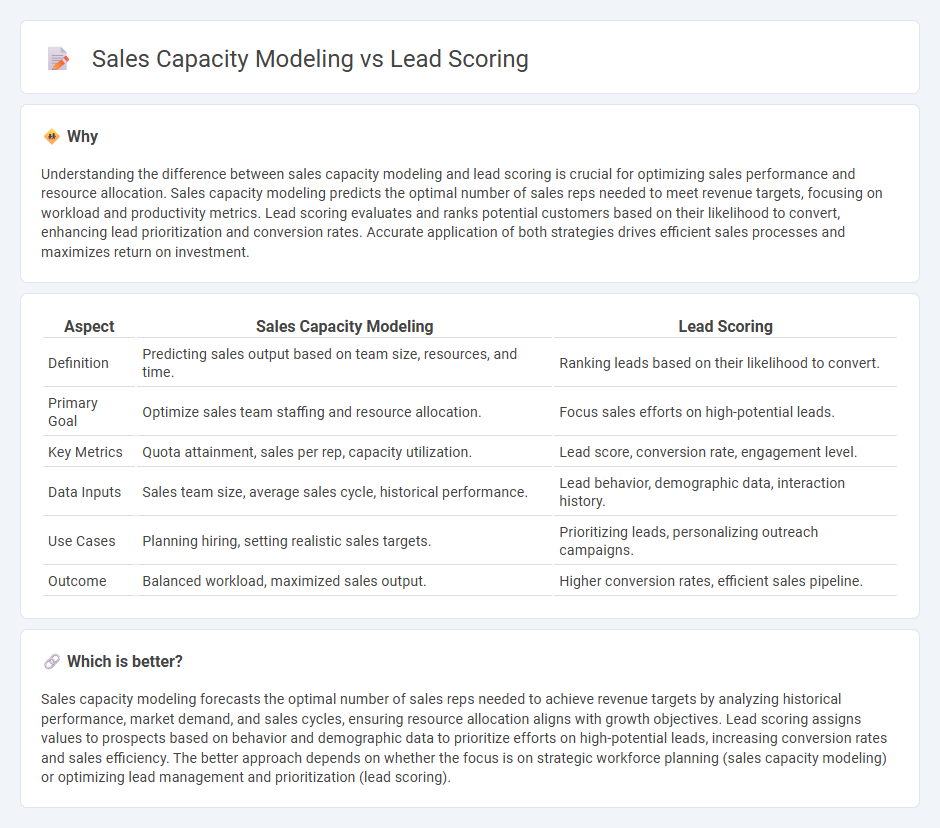
Sales capacity modeling forecasts the maximum potential sales output based on resource allocation, team size, and market conditions to optimize workforce efficiency. Lead scoring assigns value to prospects by analyzing behavior, engagement, and demographics to prioritize sales efforts and improve conversion rates. Explore the nuances between these strategic approaches to enhance revenue growth and operational effectiveness.
Why it is important
Understanding the difference between sales capacity modeling and lead scoring is crucial for optimizing sales performance and resource allocation. Sales capacity modeling predicts the optimal number of sales reps needed to meet revenue targets, focusing on workload and productivity metrics. Lead scoring evaluates and ranks potential customers based on their likelihood to convert, enhancing lead prioritization and conversion rates. Accurate application of both strategies drives efficient sales processes and maximizes return on investment.
Comparison Table
| Aspect | Sales Capacity Modeling | Lead Scoring |
|---|---|---|
| Definition | Predicting sales output based on team size, resources, and time. | Ranking leads based on their likelihood to convert. |
| Primary Goal | Optimize sales team staffing and resource allocation. | Focus sales efforts on high-potential leads. |
| Key Metrics | Quota attainment, sales per rep, capacity utilization. | Lead score, conversion rate, engagement level. |
| Data Inputs | Sales team size, average sales cycle, historical performance. | Lead behavior, demographic data, interaction history. |
| Use Cases | Planning hiring, setting realistic sales targets. | Prioritizing leads, personalizing outreach campaigns. |
| Outcome | Balanced workload, maximized sales output. | Higher conversion rates, efficient sales pipeline. |
Which is better?
Sales capacity modeling forecasts the optimal number of sales reps needed to achieve revenue targets by analyzing historical performance, market demand, and sales cycles, ensuring resource allocation aligns with growth objectives. Lead scoring assigns values to prospects based on behavior and demographic data to prioritize efforts on high-potential leads, increasing conversion rates and sales efficiency. The better approach depends on whether the focus is on strategic workforce planning (sales capacity modeling) or optimizing lead management and prioritization (lead scoring).
Connection
Sales capacity modeling and lead scoring work together to optimize resource allocation and improve sales efficiency. Capacity modeling forecasts the number of salespeople needed based on expected lead volume, while lead scoring prioritizes leads by their likelihood to convert, enabling the sales team to focus efforts on high-potential prospects. Integrating these methods enhances pipeline management and boosts overall revenue performance.
Key Terms
**Lead scoring:**
Lead scoring assigns numeric values to prospects based on their behavior and demographics, helping prioritize leads for sales focus and improve conversion rates. This method uses data-driven insights including engagement levels, firmographics, and past interactions to identify high-potential customers. Explore further how effective lead scoring can optimize your sales funnel and boost revenue generation.
Qualification criteria
Lead scoring quantifies the potential value and readiness of individual prospects by prioritizing attributes such as demographic fit, engagement level, and buying signals. Sales capacity modeling evaluates the overall team's ability to manage and close leads based on factors like sales cycle length, average deal size, and available resources. Explore how aligning lead qualification criteria with sales capacity can enhance forecasting accuracy and drive revenue growth.
Predictive analytics
Lead scoring uses predictive analytics to rank prospects based on their likelihood to convert, leveraging data such as engagement history and demographic details. Sales capacity modeling applies predictive analytics to estimate the number of sales reps needed to meet revenue targets by analyzing historical performance and market conditions. Explore these predictive analytics techniques to enhance sales efficiency and forecasting accuracy.
Source and External Links
Lead scoring - Wikipedia - Lead scoring is a methodology used to rank prospects by their perceived value to an organization, combining explicit data like job title and implicit data such as website visits, to prioritize leads for sales engagement and improve marketing and sales efficiency.
What Is Lead Scoring? Definition, Models, Best Practices - Cognism - Lead scoring assigns points based on prospect behaviors and attributes to identify which leads are ready to buy, helping sales focus on high-quality prospects and increasing conversion rates.
What is Lead Scoring? - Oracle - Lead scoring ranks sales leads objectively by combining profile fit and engagement levels to determine follow-up priority, facilitating alignment between marketing and sales and improving qualification of sales-ready leads.
 dowidth.com
dowidth.com